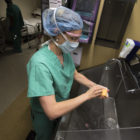Medicare Cuts Payments To 15 Hospitals For High Infection Rates, Injuries
|
Fifteen Connecticut hospitals will lose 1 percent of their Medicare reimbursements this fiscal year as penalties for having relatively high rates of hospital-acquired conditions, data from the Centers for Medicare & Medicaid Services (CMS) show. The hospitals are among 800 nationwide being penalized – the highest number since the federal Hospital Acquired Conditions Reduction Program started five years ago, according to a Kaiser Health News (KHN) analysis of the CMS data. The penalties will be levied during the current fiscal year, which began in October 2018 and runs through September. Under the program, which was created by the Affordable Care Act, the government levies penalties based on hospitals’ rates of infection related to colon surgeries, hysterectomies, urinary tract catheters and central lines inserted into veins. It also reviews infection rates for Methicillin-resistant Staphylococcus aureus, or MRSA, and Clostridium difficile, known as C. diff, as well as rates of blood clots, sepsis, post-surgery wounds, bedsores and hip fractures, among other injuries.






